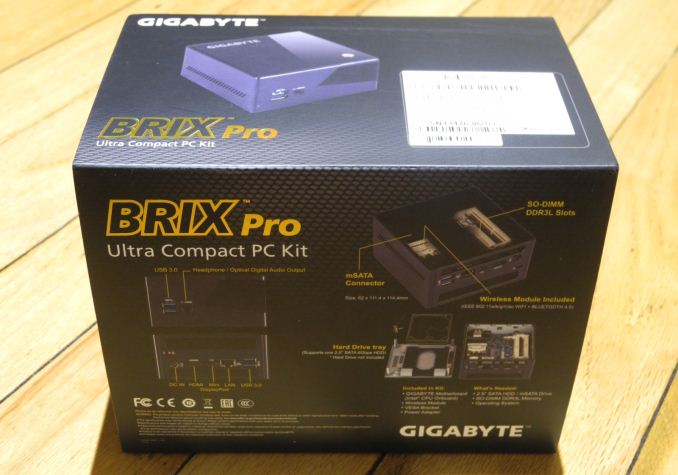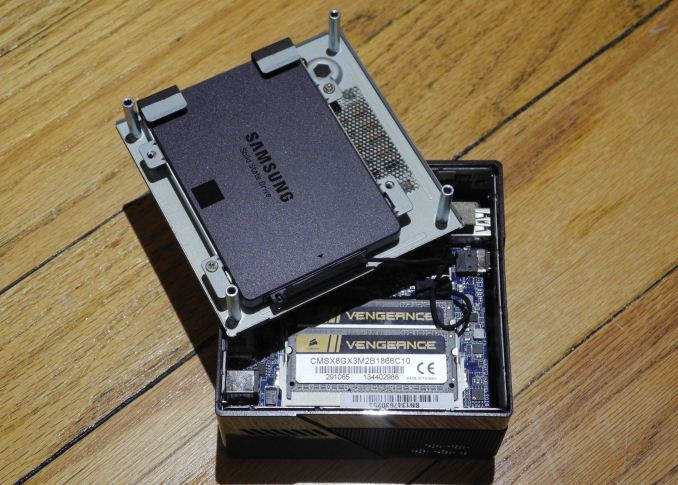GIGABYTE BRIX Pro: A Second Look at the Intel i7-4770R with Iris Pro HD 5200
by Ganesh T S on June 14, 2014 5:00 PM EST
Recap
Earlier this year, we had our first look at the GIGABYTE BRIX Pro, along with a note about further benchmarks to follow. It was our first look at the Intel Core i7-4770R, a Crystal Well part with 128 MB of eDRAM built into the package. The part was aimed squarely at making integrated graphics competetive with low-end discrete GPUs. As a direct result of this, PC manufacturers could make compact gaming units. The BRIX Pro was even distributed at the Steam Developers Conference as a Steam Machine.
In our second look at the BRIX Pro, we changed the memory and storage subsystem to better reflect the expected use case. The table below provides the components utilized for the build along with pricing information.
| Gigabyte GB-BXi7-4770R (2) Build Components | ||
| Component | Price | |
| Chassis / CPU / Motherboard / PSU | GB-BXi7-4770R | $649 |
| Memory | Corsair Vengeance CMSX8GX3M2B1866C10 2x4 GB Kit | $95 |
| SSD | Samsung SSD 840 EVO 120 GB | $90 |
|
|
||
| Total | $834 | |
Readers may remember that the first part of our BRIX Pro review used Crucial DRAM modules and an Intel mSATA drive. Gamers usually go for higher memory speeds and SATA-based 2.5" drives are usually much cheaper compared to mSATA drives for the same capacity. The Corsair memory modules are rated for 1866 MHz (compared to Crucial's 1600 MHz) and, while the capacity of the 840 EVO (120 GB) is lower than that of the Intel mSATA drive (180 GB) used earlier, it is fine for applications where games and other heavy content are stored on an external drive.
Benchmark numbers change with the new configuration and so we reran our evaluation suite. The first two sections will deal with the updated benchmark numbers. Following this, we have a section presenting our gaming benchmarks. Recently, we have started evaluating the wireless networking and storage subsystem for mini PCs and results for the BRIX Pro are presented in a separate section. We touch briefly upon the HTPC aspects before discussing the thermal aspects. However, prior to all that, we have a table presenting the details of various systems that are compared against the BRIX Pro in this review.
| Comparative PC Configurations | ||
| Aspect | GIGABYTE GB-BXi7-4770R (2) | |
| CPU | Intel Core i7-4770R | Intel Core i7-3720QM |
| GPU | Intel Iris Pro Graphics 5200 | Intel HD Graphisc 4000 |
| RAM |
Corsair Vengeance CMSX8GX3M2B1866C10 10-10-10-32 @ 1866 MHz 2x4 GB |
Super Talent W1333SB4GH 9-9-9-24 @ 1333 MHz 2x 4GB |
| Storage |
Samsung SSD 840 EVO (120 GB, 2.5in SATA 6Gb/s, 19nm, TLC) |
Intel® SSD 330 Series (60 GB, SATA 6Gb/s, 25nm, MLC) |
| Wi-Fi |
Realtek 8821AE Wireless LAN 802.11ac (1x1 802.11ac - 433 Mbps) |
N/A |
| Price (in USD, when built) | $829 | $1300 |











55 Comments
View All Comments
Dirk Broer - Sunday, June 22, 2014 - link
RAM speeds have a BIG impact on the performance of IGPs, both for Intel and AMD. Speed is even <a href="http://www.anandtech.com/show/7364/memory-scaling-... important</a> than Latency.Hrel - Monday, June 16, 2014 - link
Except that paying for that "faster" RAM costs you money and yields no tangible benefit beyond 1866. The price/performance sweet spot is 1866.http://www.anandtech.com/show/7364/memory-scaling-...
Dirk Broer - Sunday, June 22, 2014 - link
"you can easily get 2133 for a decent price" You've seen the photograph, with SoDIMMs? Where do you buy 2133 MHz SoDIMMS for a decent price?TwistedKestrel - Saturday, June 14, 2014 - link
I don't understand how graphics performance is worse if the RAM in the (2) is faster in every way. Even if you didn't use the XMP profile, it should still be faster!TwistedKestrel - Saturday, June 14, 2014 - link
I meant to say, worse in ANY scenario. The (2) should win out every time, not just some of the time.ganeshts - Saturday, June 14, 2014 - link
In areas where they are close or (1) wins out, the error is within measurement margin, but in the gaming scenarios where there is a big difference, (2) wins handsomely.Some benchmarks are also not dependent on the memory (CPU-bound).
Samus - Sunday, June 15, 2014 - link
It might be worth investigating whether the crystal well gpu can decrease CPU throughput when it is heavily taxed. That would explain why giving crystal well more memory bandwidth slightly decreases CPU performance. Although they are separate parts of the die, they communicate across the same bus and are flip-chip limited.etamin - Saturday, June 14, 2014 - link
My guess is that the difference is more related to thermals than RAM. Intel iGP's are less dependent on DRAM speeds than AMD's, especially the Crystal Well parts. Outside of the one Tomb Raider benchmark at 1080p, the performance drop isn't significant (at that FPS, it's all kind of irrelevant anyways). Since the max power draw is higher on the 2nd edition, it's probably attributed to a combination of silicon quality and throttling.dylan522p - Saturday, June 14, 2014 - link
Why did you use a 840 Evo. It is inferior to the MX100 which is also cheaper. For the same price you can get a drive with better nand and double the storage.ganeshts - Saturday, June 14, 2014 - link
Well, this piece has been in the works for a couple of months now.. When I built the refreshed config, the Samsung 840EVO was the best value for money.. I see that the MX100 came to market just a couple of weeks back..